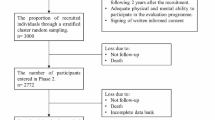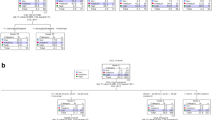Abstract
Purpose
Latent class analysis (LCA), a statistical method for identifying latent classes within a population using multiple indicators, has been used to study the heterogeneity of health among the elderly. We aim to identify health status profiles of older adults using LCA and examine the socio-demographic characteristics associated with each profile.
Methods
A community health survey of residents ≥60 years was conducted in Marine Parade, Singapore. We performed LCA on seven health indicators (number of chronic conditions, activities of daily living (ADL) dependency, pain, depression, cognition, social isolation, and frequency of socialising) to identify distinct classes of health status profiles. Multivariable logistic regression was conducted to examine the socio-demographic characteristics associated with each profile.
Results
Of the 2,444 elderly interviewed, we identified two health status profiles: “Health at risk” (n = 465, 19.0 %), and “Relatively healthy” (n = 1,979, 81.0 %). The “Health at risk” profile was characterised by high probabilities of 3+ chronic conditions (λ = 0.63), at least one basic/instrumental ADL dependency (λ = 0.56), moderate/extreme pain (λ = 0.55), cognitive impairment (λ = 0.29), depressive symptoms (λ = 0.29), social isolation (λ = 0.27), and infrequent socialisation (λ = 0.61). Individuals who were older (65–74, 75–84, and 85+ years), females, of non-Chinese ethnicity (Indian, Malay, and Others), had primary and lower education, and were unemployed/not employed were more likely to be “Health at risk”.
Conclusion
Using LCA, we identified two distinct health status profiles which accounted for the heterogeneity of the elderly population. Selected socio-demographic characteristics were associated with different profiles and provide implications for the structuring of future public health interventions targeting the older population.

Similar content being viewed by others
References
Chan, A., Malhotra, C., Malhotra, R., & Ostbye, T. (2011). Living arrangements, social networks and depressive symptoms among older men and women in Singapore. International Journal of Geriatric Psychiatry, 26, 630–639.
MCYS. (2006). Committee on ageing issues: Report on the ageing population. Singapore: MCYS. app.msf.gov.sg/Portals/0/Summary/research/CAI_report.pdf.
Orrell, M., & Hancock, G. A. (Eds.). (2004). CANE: The Camberwell assessment of need for the elderly. London: Gaskell.
WHO. (2003). WHO definition of Health. Geneva: WHO (25 February 2013). http://www.who.int/about/definition/en/print.html.
Fried, L. P., Ferrucci, L., Darer, J., Williamson, J. D., & Anderson, G. (2004). Untangling the concepts of disability, frailty, and comorbidity: Implications for improved targeting and care. The Journals of Gerontology Series A: Biological Sciences and Medical Sciences, 59(3), 255–263.
Inouye, S. K., Studenski, S., Tinetti, M. E., & Kuchel, G. A. (2007). Geriatric syndromes: Clinical, research and policy implications of a core geriatric concept. Journal of the American Geriatrics Society, 55(5), 780–791.
Tomaka, J., Thompson, S., & Palacios, R. (2006). The relation of social isolation, loneliness, and social support to disease outcomes among the elderly. Journal of Aging and Health, 18(3), 359–384.
Topinkova, E. (2008). Aging, disability and frailty. Annals of Nutrition and Metabolism, 52(Suppl 1), 6–11.
Lafortune, L., Beland, F., Bergman, H., & Ankri, J. (2009). Health status transitions in community-living elderly with complex care needs: A latent class approach. BMC Geriatrics, 9(6), 1–14.
Mackenbach, J. P. (2006). Health inequalities: Europe in profile. http://www.who.int/social_determinants/resources/european_inequalities.pdf.
Wickrama, K. A. S., Mancini, J. A., Kwag, K., & Kwon, J. (2013). Heterogeneity in multidimensional health trajectories of late old years and socioeconomic stratification: A latent trajectory class analysis. Journals of Gerontology. Series B, Psychological Sciences and Social Sciences, 68(2), 290–297.
Humphreys, E. (2008). Health inequalities and ageing in the community. Limerick, Ireland: University of Limerick & Mid-western Regional Hospital Limerick. http://www.hsyrc.com/Images/Updates/January2009/Ageing_FinalRpt.pdf.
Crimmins, E. M., Kim, J. K., & Seeman, T. E. (2009). Poverty and biological risk: The earlier “aging” of the poor. The Journals of Gerontology Series A: Biological Sciences and Medical Sciences, 64A(2), 286–292.
Ferraro, K. F., & Shippee, T. P. (2009). Aging and cumulative inequality: How does inequality get under the skin? The Gerontologist, 49(3), 333–343.
George, P. P., Heng, B. H., Molina, J. A. D., Wong, L. Y., Ng, C. W. L., & Cheah, J. T. S. (2012). Self-reported chronic diseases and health status and health service utilisation—Results from a community health survey in Singapore. International Journal for Equity in Health, 11, 44.
Wee, L. E., Yeo, W. X., Yang, G. R., Hannan, N., Lim, K., Chua, C., et al. (2012). Individual and area level socioeconomic status and its association with cognitive function and cognitive impairment (low MMSE) among community-dwelling elderly in Singapore. Dementia and Geriatric Cognitive Disorders Extra, 2, 529–542.
Yong, V., Saito, Y., & Chan, A. (2011). Gender differences in health and health expectancies of older adults in Singapore: An examination of diseases, impairments, and functional disabilities. Journal of Cross-Cultural Gerontology, 26, 189–203.
Liu, L. F., Tian, W. H., & Yao, H. P. (2012). Utilisation of health care services by elderly people with National Health Insurance in Taiwan: The heterogeneous health profile approach. Health Policy, 108, 246–255. doi:10.1016/j.healthpol.2012.08.022.
Schuz, B., Wurm, S., Warner, L. M., & Tesch-Romer, C. (2009). Health and subjective well-being in later adulthood: Different health states—Different needs? Applied Psychology: Health and Well-Being, 1(1), 23–45.
The Pennsylvania State University. (2012). Latent transition analysis (LTA). Pennsylvania, USA: The Pennsylvania State University (25 February 2013). http://methodology.psu.edu/ra/lta.
Muthen, B., & Muthen, L. K. (2000). Integrating person-centered and variable-centered analyses: Growth mixture modeling with latent trajectory classes. Alcoholism, Clinical and Experimental Research, 24(6), 882–891.
Ministry of Community Development Youth and Sports. (2005). National Survey of Senior Citizens 2005. Singapore: Ministry of Community Development Youth and Sports.
Ministry of Health. (2007). National Health Surveillance Survey 2007. Singapore: Ministry of Health.
Ng, T. P., Niti, M., Chiam, P. C., & Kua, E. H. (2006). Prevalence and correlates of functional disability in multiethnic elderly Singaporeans. Journal of the American Geriatrics Society, 54, 21–29.
Rabin, R., Oemar, M., Oppe, M., & EuroQol Group Executive Office on behalf of the EuroQOL Group. (2011). EQ-5D-3L user guide: Basic information on how to use EQ-5D-3L instrument (Version 4.0). EuroQol Group. http://www.euroqol.org/fileadmin/user_upload/Documenten/PDF/Folders_Flyers/UserGuide_EQ-5D-3L.pdf.
Hodkinson, H. M. (1972). Evaluation of a mental test score for assessment of mental impairment in the elderly. Age and Ageing, 1(4), 233–238.
Chin, J. J. (2002). Screening for cognitive impairment in primary care: The role of objective cognitive tests. The Singapore Family Physician, 28(4), 62–68.
Jitapunkul, S., Pillay, I., & Ebrahim, S. (1991). The abbreviated mental test: Its use and validity. Age and Ageing, 20, 332–336.
Lim, P. P. J., Ng, L. L., Chiam, P. C., Ong, P. S., Ngui, F. T. S., & Sahadevan, S. (2000). Validation and comparison of three brief depression scales in an elderly Chinese population. International Journal of Geriatric Psychiatry, 15, 824–830.
Nyunt, M. S. Z., Fones, C., Niti, M., & Ng, T. P. (2009). Criterion-based validity and reliability of the Geriatric Depression Screening Scale (GDS-15) in a large validation sample of community-living Asian older adults. Aging and Mental Health, 13(3), 376–382.
Thilagaratnam, S., Ding, Y. Y., Au Eong, K. G., Chiam, P. C., Chow, Y. L., Khoo, G., et al. (2010). Health Promotion Board-Ministry of Health clinical practice guidelines: Functional screening for older adults in the community. Singapore Medical Journal, 51(6), 518–522.
Singapore Department of Statistics. (2011). Key household characteristics and household income trends. Singapore: Singapore Department of Statistics.
Muthen, L. K., & Muthen, B. O. (1998–2010). Mplus user’s guide (6th ed.). Los Angeles, CA: Muthen & Muthen.
Chang, W. C., Lu, F. P., Lan, T. Y., & Wu, S. C. (2012). Multidimensional health-transition patterns among a middle-aged and older population. Geriatrics Gerontology International,. doi:10.1111/j.1447-0594.2012.00937.x.
Lanza, S. T., Collins, L. M., Lemmon, D. R., & Schafer, J. L. (2007). PROC LCA: A SAS procedure for latent class analysis. Structural Equation Modeling, 14(4), 671–694.
Chan, A., & Jatrana, S. (2007). Gender differences in health among older Singaporeans. International Sociology, 22(4), 463–491.
Fong, C. W., Bhalla, V., Heng, D., Chua, A. V., Chan, M. L., & Chew, S. K. (2007). Educational inequalities associated with health-related behaviours in the adult population of Singapore. Singapore Medical Journal, 48(12), 1091–1099.
Wister, A. V. (1996). The effects of socioeconomic status on exercise and smoking: Age-related differences. Journal of Aging and Health, 8(4), 467–488.
Schwingel, A., Niti, M. M., Tang, C., & Ng, T. P. (2009). Continued work employment and volunteerism and mental well-being of older adults: Singapore longitudinal ageing studies. Age and Ageing, 38, 531–537.
Hagenaars, J. A., & McCutcheon, A. L. (Eds.). (2002). Applied latent class analysis. Cambridge: Cambridge University Press.
Lafortune, L., Beland, F., Bergman, H., & Ankri, J. (2009). Health state profiles and service utilisation in community-living elderly. Medical Care, 47(3), 286–294.
Acknowledgments
This study was part of the Marine Parade Elderly Needs Survey Project, which was commissioned by the Agency for Integrated Care, Singapore.
Author information
Authors and Affiliations
Corresponding author
Rights and permissions
About this article
Cite this article
Ng, C.W.L., Luo, N. & Heng, B.H. Health status profiles in community-dwelling elderly using self-reported health indicators: a latent class analysis. Qual Life Res 23, 2889–2898 (2014). https://doi.org/10.1007/s11136-014-0723-7
Accepted:
Published:
Issue Date:
DOI: https://doi.org/10.1007/s11136-014-0723-7




